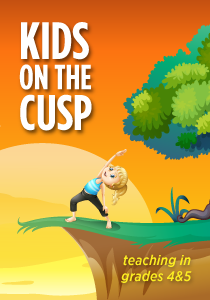It’s All in the Delivery
A MiddleWeb Blog
I am experiencing different emotions since beginning to analyze (okay…over-analyze) my ability to teach via the new on-line teacher evaluation self-assessment that has been adopted by my state.
The first domain was used to assess my ability to plan and prepare effective lessons. It started off on a high-note. Some of the verbiage in the Teacher Evaluation Rubrics (developed by Kim Marshall and adapted/adopted by New Jersey) is hard to digest, but I’m a planner. I get comfort out of having my ducks in a row.
The second domain in Marshall’s plan focused on my managing my classroom and my kids. I started feeling a little frustrated during an analysis of the sub-categories in this area. Being told what “managing effectively” means by a group of people who aren’t managing their own responsibilities very well seems ironic. I can find the humor in it, but that’s just my way of coping with the noise.
There is a cacophony blaring within state government. Loud notes of disharmony are being played, negatively affecting teacher performance. On-line evaluation practices, administrative overload, and school budget restraints are causing audible discord. Let’s just say I don’t think they are handling their money well.
Still, self-assessment is essential if I am going to grow as an educator. This rubric rating process has been positive for the most part. I just wish the state would self-assess a bit more accurately. Their decisions also have an impact on my effectiveness (and sometimes my attitude).

At times, like a lot of teachers, I feel like a performer whose job is to entertain the crowd. Sometimes I feel like I am doing a stand-up comedy routine. Thankfully, for myself and my students, I associate effective delivery with a decent punch-line…and I usually deliver. The audience seems receptive and appreciative.
I’m hoping to find some levity, as I ponder my ability to hold a captive audience of 23 this year.
Domain C: Delivery of Instruction
(a) Expectations: I feel lighter. I awarded myself a rating of Highly Effective in this area. “Effective” only asks that I convey to my students that they can be successful. Highly effective teachers, “exude high expectations and convince all students that they can master the material.” I exude. I think each child in my classroom feels they are capable of understanding and mastering whatever concept we are exploring. (I have my doubts about a few of them from time to time, but I don’t let them know it!)
(b) Mindset: A second “Highly Effective” has been awarded. It reflects my ability to encourage kids to “take risks and learn from mistakes.” I model this behavior beautifully by making frequent mistakes (I also model recognizing the same mistakes when I make them again).
(c) Goals: Uh-oh…This is my first Partially Effective “2” score. To be highly effective in this sub-category, I need to “show students exactly what’s expected by posting essential questions, goals, rubrics, and exemplars of proficient work.” I don’t have enough wall space in the room for all of this posting. I show my kids many examples of good work, identify what is expected of them, and try to convey its relevance to their lives. We have a morning meeting on most days, but the bottom line is that I’m a 2. I admit it. I “tell students the main objectives of each lesson.” (Actually, there are times I don’t even do this. I believe it’s called the constructivist approach when you let them discover some things for themselves? But that seems to be what the rating of Ineffective is referring to.)
(d) Connections: Four. I think I may have been trying to boost my numeric average here by over-estimating my ability to “hook all students’ interest and make connections to prior knowledge, experience and reading.” I do have an uncanny ability to improvise. We read a lot. There is a need for both in a school environment. Interruptions are frequent and distracting to all of us. We certainly do make connections in our day to day interactions and within topics of study. It just gets a little muddled sometimes.
(e) Clarity: That word makes me think of assessing the worth of a diamond. Clarity of instruction does have great worth. To be effective we must use “clear explanations, appropriate language, and examples to present material.” Appropriate language is subjective. And varies. That’s good. We have moments of risqué potty humor in our room…I think it’s appropriate for the age level.

(g) Engagement: If I am highly efficient in this area, I must get all students involved in focused work. Children who have difficulty staying focused can be found in classrooms across the country. The differing opinions on ways to address attention issues are vast. Maybe teachers shouldn’t be held accountable for all students focusing in class. That’s a shared responsibility.
(h) Differentiation: I rated myself as Partially Efficient (another 2!) in this category. Differentiation was a buzz-word years ago in my district. The level of tiered lesson planning and paperwork attached to this term was a source of angst. I would love to be a 4 in this category. I would love to be able to “successfully reach all students by skillfully differentiating and scaffolding.” I aspire to do that. Right now though, with all the juggling going on in the education system and dwindling resources being awarded by the state, I’m only a 2 who “attempts to accommodate students with learning deficiencies, but with mixed success.”

(j) Application: I rated myself as Efficient (that’s a 3) in this last category. It requires that we help students sum up what they have learned and apply it in a different context. Well, children, the Delivery of Instruction (noun) is the practice of doing stand-up comedy or improvisation while conducting an orchestra. Maybe I deserve the 4.
Dim the lights. Raise the curtain. The show must go on.


































